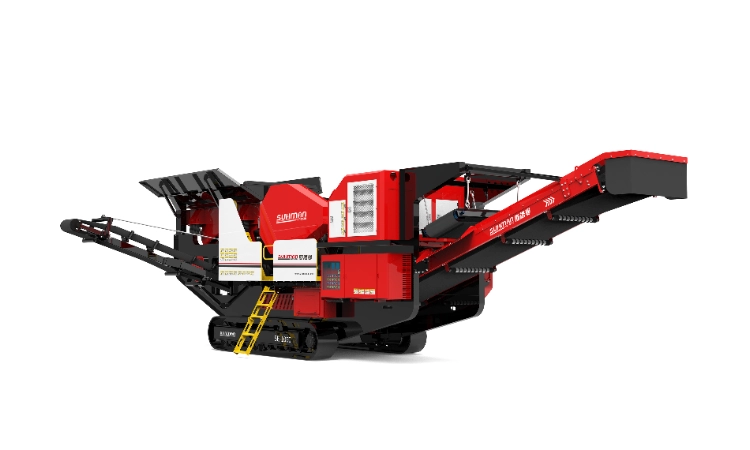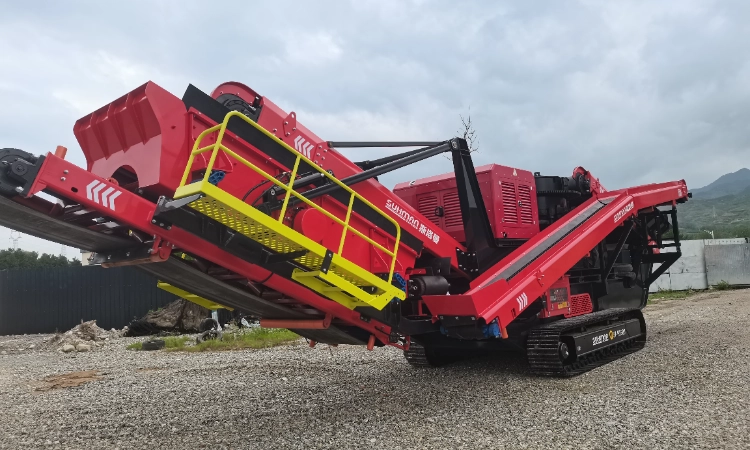How Small Jaw Crushers Boost Productivity in Tight Spaces
Release time: 2025-03-15
The demand for efficient crushing equipment has never been higher, especially in industries like mining, construction, and recycling. Among the myriad options available, small jaw crushers stand out for their ability to deliver powerful performance in a compact package. These machines are not just scaled-down versions of their larger counterparts; they are purpose-built solutions tailored to meet the needs of smaller operations or specific tasks within larger projects.

What is a Small Jaw Crusher?
At its core, a small jaw crusher is a type of primary crushing equipment designed to reduce large rocks, ores, and other materials into smaller, manageable pieces. It operates using a simple yet effective mechanism: material is fed into a chamber where it’s compressed between a stationary jaw and a moving jaw, driven by an eccentric shaft. The result? A consistent output of crushed material, ready for further processing or use.
How It Works
The process begins when material enters the crusher’s feed opening. The moving jaw, powered by a motor (electric or diesel), swings back and forth, pressing the material against the fixed jaw. This compressive force fractures the material, which then exits through an adjustable discharge opening at the bottom. The size of the output can be fine-tuned by adjusting this gap, making small jaw crushers highly adaptable to various needs.
Defining “Small”
So, what qualifies as “small” in the world of jaw crushers? Typically, these machines have a feed opening smaller than 300mm (e.g., 150mm x 250mm or 200mm x 300mm) and a capacity ranging from 1 to 20 tons per hour. They’re lighter—often weighing between 500 kg and 5,000 kg—and more compact than industrial-grade crushers, making them ideal for operations where space and mobility are key considerations.
Core Components
- Frame: A robust structure, usually steel or cast iron, that supports the crusher.
- Jaws: Made of durable manganese steel, the fixed and moving jaws do the heavy lifting.
- Eccentric Shaft: Drives the moving jaw’s motion.
- Toggle Plate: Adjusts the discharge opening and acts as a safety mechanism.
- Flywheel: Balances the crusher’s operation for smoother performance.
For a deeper dive into portable options, check out the Mobile Jaw Crusher for Hard Rock, which exemplifies how compact design meets rugged functionality.
Key Benefits of Small Jaw Crushers
Why should B2B clients consider small jaw crushers? The advantages are numerous and tailored to the realities of modern industrial needs. Here’s a closer look:
1. Cost-Effectiveness
Purchasing and operating a small jaw crusher is significantly less expensive than larger models. The initial investment is lower, spare parts are more affordable, and energy consumption is minimal—perfect for budget-conscious businesses or those testing the waters in new markets.
2. Portability
Many small jaw crushers are designed with mobility in mind. Mounted on wheels or tracks, they can be transported easily between job sites, reducing logistics costs and downtime. This makes them a favorite for contractors juggling multiple projects.
3. Versatility
From crushing hard granite to processing recycled concrete, these machines handle a wide range of materials. Adjustable settings allow operators to customize output sizes, making them suitable for diverse applications.
4. Space Efficiency
Their compact footprint is a major plus in urban environments or cramped worksites. A small jaw crusher can fit where larger machines can’t, delivering performance without dominating space.
5. Ease of Maintenance
With fewer moving parts and a straightforward design, maintenance is simpler and less frequent. This translates to lower repair costs and less downtime—a win for any operation.
6. Energy Efficiency
Smaller motors mean less power draw. Whether powered by electricity or diesel, small jaw crushers keep operating costs down while maintaining productivity.
For a modular take on this efficiency, explore the Efficient Mini Modular Jaw Crusher, blending portability with cutting-edge design.
Applications Across Industries
The adaptability of small jaw crushers makes them invaluable across multiple sectors. Here’s how they’re transforming operations:
Small-Scale Mining
In regions where large-scale mining isn’t feasible, small jaw crushers process ores like gold, copper, or limestone on-site. Their portability allows miners to crush materials directly at the source, slashing transportation expenses.
Construction and Demolition
Urban projects often generate concrete and asphalt waste. Small jaw crushers turn this debris into reusable aggregate, supporting sustainability and cutting material costs. They’re especially useful in tight spaces where heavy machinery can’t maneuver.
Recycling
From glass bottles to electronic waste, these crushers handle recyclable materials with ease. They help businesses meet environmental goals while generating usable outputs.
Laboratory Use
Research institutions rely on small jaw crushers to prepare rock samples for analysis. Their precision and compact size make them a staple in geological studies.
Quarrying
Small quarries use these machines to produce aggregates for local construction projects, offering a cost-effective alternative to larger setups.
Here’s a quick table summarizing key applications:
| Industry | Application | Benefits |
|---|---|---|
| Mining | Ore crushing | On-site processing, cost savings |
| Construction | Debris recycling | Space efficiency, sustainability |
| Recycling | Glass, electronics crushing | Environmental compliance |
| Laboratory | Sample preparation | Precision, compact design |
| Quarrying | Aggregate production | Affordable output |
Choosing the Right Small Jaw Crusher
Selecting the perfect small jaw crusher requires careful consideration. Here’s a step-by-step guide for B2B buyers:
Step 1: Assess Material Type
Hardness and abrasiveness matter. Granite demands a tougher crusher than limestone. Check the machine’s capacity to handle your specific material.
Step 2: Define Output Requirements
Need fine gravel or coarse chunks? Ensure the crusher’s discharge setting aligns with your desired particle size. Capacities typically range from 1-20 tons per hour—match this to your throughput needs.
Step 3: Mobility Needs
Will you move the crusher often? Portable models, like the Mobile Jaw Crusher Plus with Powerful Crushing Ability, are ideal for multi-site operations.
Step 4: Power Source
Electric crushers suit stable power grids, while diesel or hybrid options thrive in remote areas. Factor in fuel costs and availability.
Step 5: Budget and Support
Balance upfront costs with long-term value. Look for suppliers offering warranties and readily available spare parts to minimize downtime.
Maintenance Tips for Optimal Performance
To keep your small jaw crusher running smoothly, follow these maintenance practices:
- Daily Checks: Inspect jaws, bearings, and belts for wear.
- Lubrication: Grease moving parts every 40-50 hours of use.
- Cleaning: Clear debris from the chamber post-operation.
- Part Replacement: Swap out worn jaw plates to maintain efficiency.
- Adjustments: Regularly tweak the discharge gap for consistent output.
Proper care extends lifespan and boosts ROI—crucial for B2B clients managing tight schedules.
Comparing Small Jaw Crushers to Other Crusher Types
How do small jaw crushers stack up against alternatives? Let’s break it down:
vs. Cone Crushers
- Use: Primary (jaw) vs. secondary/tertiary (cone).
- Cost: Jaw crushers are cheaper and simpler.
- Output: Cones produce finer material.
vs. Impact Crushers
- Method: Compression (jaw) vs. impact force.
- Material: Jaws excel with hard rocks; impacts suit softer recycling tasks.
vs. Hammer Mills
- Purpose: Primary crushing (jaw) vs. grinding (mill).
- Complexity: Jaws are easier to maintain.
For soft rock applications, consider the Modular Impact Crusher for Crushing Soft Rock as an alternative.



Real-World Case Studies
Case 1: Mining in Southeast Asia
A small mining outfit needed to crush quartz on-site. A small jaw crusher cut transport costs by 35%, boosting profits.
Case 2: Urban Redevelopment
A contractor in a city center recycled concrete with a portable crusher, saving space and meeting green building standards.
Case 3: Research Lab
A university used a small jaw crusher to process samples, speeding up analysis by 40%.
Technical Specifications and Features
Here’s a sample table of typical small jaw crusher specs:
| Model | Feed Opening (mm) | Capacity (t/h) | Power (kW) | Weight (kg) |
|---|---|---|---|---|
| SJC-150 | 150 x 250 | 1-3 | 5.5 | 800 |
| SJC-200 | 200 x 300 | 3-10 | 15 | 2,000 |
| SJC-250 | 250 x 400 | 5-20 | 22 | 3,500 |
Features like adjustable jaws and mobile designs enhance functionality



